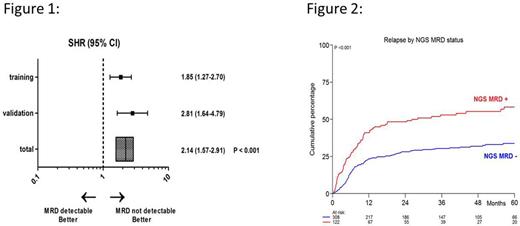Abstract
Introduction:
Although the majority of Acute Myeloid Leukemia (AML) patients achieve a complete morphological remission (CR) after induction therapy, relapse rates remain high. Molecular Minimal Residual Disease (MRD) detection by PCR-based technologies has been shown to improve relapse prediction but has been restricted to specific genetically-defined subsets of AML only. Next-Generation Sequencing (NGS) has the advantage that it allows for the assessment of a broad range of disease-related gene mutations in a single assay. Residual leukemia-specific mutations in bone marrow in morphological CR after induction therapy are supposed to represent the source of relapse. However, persistent mutations may also represent clonal hematopoiesis, analogous to age-related clonal hematopoiesis of indeterminate potential (CHIP) present in healthy individuals. It is currently unknown which and to what extent the persisting somatic mutations after induction therapy contribute to AML relapse. Here, we present a comprehensive study, detailing the value of molecular MRD detection by NGS, in a large prospective cohort of newly diagnosed AML.
Methods:
482 AML patients (<65 years) were treated with 2 cycles of standard induction chemotherapy followed by consolidation in HOVON-SAKK clinical trials (www.hovon.nl). NGS was performed to detect mutations in a panel of 54 genes frequently mutated in myeloid malignancies (Illumina) at diagnosis and in bone marrow in morphological CR after completion of induction therapy. Thompson-Tau outlier testing was performed to reliably detect persisting mutations above background error rates. The primary and secondary endpoints of the study were relapse and overall survival, respectively. To establish and subsequently test our definition of NGS MRD, the cohort was split into a representative training (n=283) and validation cohort (n=147). The Cumulative Incidence of Relapse (CIR) was estimated with competing-risks regression analyses according to the method of Fine & Gray. The Cox proportional hazard model was used to calculate overall survival estimates. P-values <0.05 were considered significant.
Results:
In 430 out of 482 (89.2%) AML patients somatic driver mutations were present at diagnosis. In 51.4% of subjects persisting mutations were detected in bone marrow in morphological CR at highly variable variant allele frequencies (VAF 0.0002-0.47), predominantly persisting in DNMT3A (78.7%), TET2 (54.2%) and ASXL1 (51.6%). These persistent mutations in DNMT3A, TET2 and ASXL1 (DTA) in the training cohort did not associate with the incidence of relapse at any VAF cut-off, indicating a stage of clonal hematopoiesis rather than a condition of impending relapse. In contrast, in the subset of AML patients with persisting DTA mutations, a significant correlation with relapse was observed when any other persistent non-DTA mutation was considered (training cohort: 5-years CIR 76.4% vs. 39.4%; p=0.002). In the training cohort NGS MRD, as defined by persistent non-DTA mutations, was found to be highly associated with the risk of relapse (SHR:1.85 [95%CI 1.27-2.70]; p=0.001), which was confirmed in the validation set (SHR:2.81 [95%CI 1.64-4.79]; p<0.001) (Fig. 1). In fact, NGS MRD was significantly associated with CIR when the training and validation series were combined (5-years CIR 58.3% versus 33.9% (p<0.001)) (Fig. 2). In addition, NGS MRD predicted for reduced survival in both cohorts (training: HR:1.64 [95%CI 1.12-2.42]; p=0.012 and validation: HR:3.08 [95%CI 1.87-5.08]; p<0.001). Finally, multivariable analysis including the data of all 430 AML patients, with adjustment for age, WBC, ELN2017 risk and number of induction cycles needed to achieve CR, revealed that NGS MRD expresses profound independent prognostic significance for relapse (SHR:1.89 [95%CI:1.34-2.65]; p<0.001) and overall survival (HR:1.64 [95%CI:1.18-2.27]; p=0.003). In sensitivity analysis with time-dependent correction for allogeneic stem cell transplantation NGS MRD remained highly prognostic for relapse and survival.
Conclusions:
In an unprecedentedly large prospective study including training and validation cohorts, targeted NGS MRD detection is established as a powerful and independent predictor for relapse and survival. NGS MRD is applicable in virtually all newly diagnosed adults with AML while persistent CHIP-related mutations lack prognostic value.
Ossenkoppele:J&J: Consultancy, Honoraria; Celgene: Honoraria, Research Funding; Karyopharm: Consultancy, Research Funding; Roche: Honoraria; Novartis: Research Funding.
Author notes
Asterisk with author names denotes non-ASH members.


This feature is available to Subscribers Only
Sign In or Create an Account Close Modal